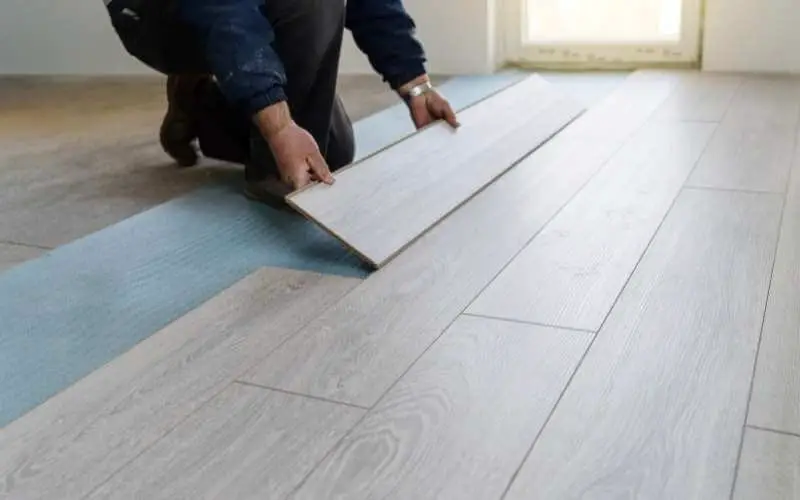Laminate floors are causing a rave amongst homeowners as the flooring type completely mimics the appearance of hardwood floors without costing half as much as natural wood.
This is a budget-friendly flooring but is not any less attractive than their expensive counterpart- original hardwood.
Can you seal laminate flooring with polyurethane? The answer is No! Polyurethane isn’t the best type of sealer to use on laminate flooring.
Sealing is a maintenance procedure carried out on hardwood floors to protect them from moisture.
So since laminate flooring shares close similarities to hardwood, it would only make sense if it is also sealed with polyurethane but no it isn’t.
Sealing your laminate floor will help it to resist spills better and offer greater durability, but there’s a lot more to this task than simply picking up a basic can of sealer and applying it to your laminate.
Keep reading to find out more about sealing laminate floors.
Related: Can you Burn Laminate Flooring?
Can You Seal Laminate Flooring With Polyurethane?
Table of Contents
Polyurethane is a popular sealer commonly used on hardwood floors to protect it from moisture and preserve its natural look from scratches and other minuscule damage that could cause the surface of the hardwood to deteriorate over time.
But can you seal laminate flooring with polyurethane? The answer is no! Polyurethane isn’t the best type of sealer to use on laminate flooring.
Laminate flooring is covered with resin, and this can make it difficult for the polyurethane to adhere well to the floor.
Unlike other flooring types like hardwood, laminate flooring cannot be sanded to encourage cohesion between the floor and product, making it difficult to get the polyurethane to stick.
You would need to opt for other types of sealers that are suitable for laminate floors.
How to Seal Laminate Flooring
Before you begin the process of sealing your laminate floor, be sure to read the instructions on the sealant container, you should find notes about required pre-cleaning to be carried out on the floor you intend to seal as well as other important information regarding how to use the product.
Also, ensure to dry the surface completely before getting started.
1. Remove Baseboards
Remove any baseboard you may have in place using a straight prybar with a thin block of plywood wedged between the prybar neck and the wall and tug off the baseboard.
This exposes the edge of the laminate flooring so that you can apply the sealant to the entirety of the floor and ensures more security for the sealant as well, giving it something to grip to.
For painted baseboards, use a utility knife to cut the paint and caulking, where the baseboard meets the wall, as well as areas where it meets other pieces of baseboard and door casing.
Read: How to Install Laminate Flooring in a RV With Slide Outs
2. Apply the Sealants
Apply your sealant to the prepped floor using a small, natural bristle brush. Start by applying a line of sealant all around the perimeter of the room exercise extra care when sealing the areas around cabinets and doorjambs, particularly when those doorjambs lead to moisture-prone areas like the bathroom or laundry room.
Also, apply the sealants carefully around plumbing fixtures, too. As well as around toilet bases, sink bases, bathtubs, and shower enclosures. Plan your application route and work towards an exit so you do not trap yourself in a corner.
Also, seal the seams between the floorboards after you have completed the perimeter. If you are using a silicone caulk sealant, cut the smallest possible hole at the end of the caulk tube and press out the caulking over the seam.
Go back over the caulking with a wet finger or putty knife to smooth out excess caulking.
3. Allow the Sealant To Dry
Allow the sealant to dry per the manufacturer’s instructions before returning the vent cover removed during the application process. Also, return the baseboards and attach them to the flooring using new nails.
Once the baseboard is reinstalled, cover the nail holes using putty and allow it to dry before applying another coating of paint or varnish to the baseboard to seal it and hide any scratch or scuffle left on the surface of the baseboard during the removal and reinstallation process.
Read: Can You Put Laminate Flooring Over Linoleum?
Conclusion
No! You can’t seal laminate flooring with polyurethane, but there are other suitable sealant types that you can use on your laminate floor to protect it from moisture.
Polyurethane will not adhere to laminate because the flooring contains resin and because it cannot be sanded, there will be poor cohesion between the floor and the sealer.
Not to worry, as you can still protect your laminate floor from damage using any other sealant suitable for laminate.

